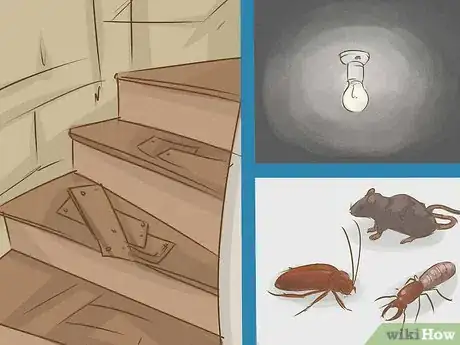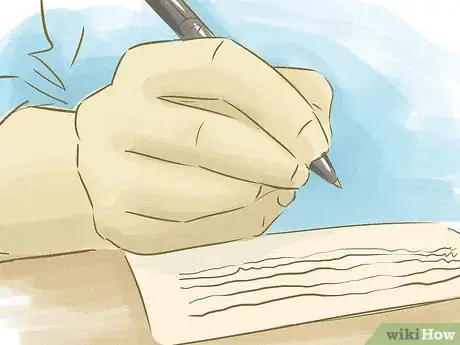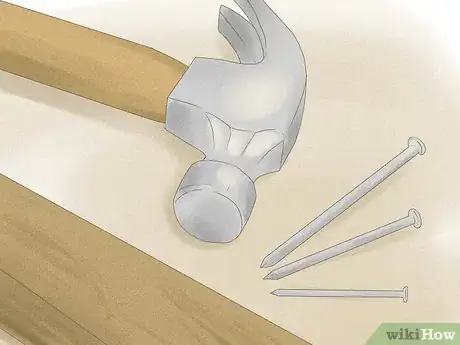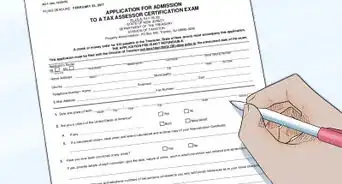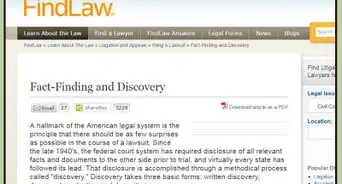This article was co-authored by Clinton M. Sandvick, JD, PhD. Clinton M. Sandvick worked as a civil litigator in California for over 7 years. He received his JD from the University of Wisconsin-Madison in 1998 and his PhD in American History from the University of Oregon in 2013.
There are 8 references cited in this article, which can be found at the bottom of the page.
This article has been viewed 40,160 times.
Every city and county has rules that building owners must follow to keep their buildings safe and sanitary. These rules can be found in the applicable building code and housing code. If the owner fails to follow the code, then you can report a violation. Most often, you will report violations in your apartment building. However, anyone can report building violations, including neighbors or strangers.
Steps
Collecting Evidence of the Violation
-
1Identify the violation. Each state or county has detailed requirements that building owners must follow. You can find a copy of your building code by visiting your county or city office. Generally, the following are violations which you can report:[1] [2] [3]
- Improper bathroom venting. Bathroom air must be expelled outside, not into an attic or other enclosed space.
- Inadequate handrails. The end of a handrail must make a 90 degree turn and meet the wall. If it doesn’t, then it’s a violation.
- Dangerous electrical work. Builders must follow complex rules to make sure that electrical wiring has been done safely. If the wiring looks dangerous, or if you have seen sparks coming from wiring, then you can report a violation.
- Pest infestation. A building overrun with pests or vermin is not habitable. You should report any pest infestation as a violation of the housing code.
- Insufficient heat or water. Each code will state when the apartment must be heated and to what temperature. If a landlord does not provide sufficient heat or water, then it has violated the code.
-
2Take pictures of any hazards. You will want evidence of the code violation. Accordingly, you should take color photographs.[4] For example, if you have a dangerous electrical box, then take a picture of it.
- Take pictures from many different angles and make sure that the pictures are clear.
Advertisement -
3Write down detailed information. Some violations can’t be photographed. Nevertheless, you need to document them as best as you can. You will need this information later, for example if you are sued for withholding rent.
- If your building is not sufficiently heated, then you will need to carefully document the temperature each day. Keep a log and document the temperature outside and the temperature inside at various points in the day.
Reporting the Violation
-
1Find the appropriate office. Each city or county should have an office that collects complaints and investigates them. You can look in your phone book under your city or county government. Look for a “Property Standards” or “Planning and Development” department.[5]
- You can also search the Internet, which will probably be easiest. Type your city or county and “report a building code violation” into your favorite search engine.
-
2Report a violation. In many cities and counties, you can report a violation over the phone or online. You should check whether online reporting is available. If so, then you can enter the information on the web form, if one is available. To report, gather the following information:[6]
- your name and contact information
- a description of the violation
- the location of the violation
- an image of the violation, which you can attach
- any other comments
-
3Decide whether to report anonymously. Many offices give you the ability to report anonymously.[7] You should consider this option if you are afraid of angering the property owner. For example, a neighbor might have become upset if you spoke to him about all of the junk in his front yard. In this situation, you might not want him to know that you were the person who reported the building violation.
- However, if you are a tenant, then you might want to give your name. Your apartment address will probably show up on the inspector’s report in any event. You won’t gain much by remaining anonymous.
-
4Meet with an inspector. The city or county should send a code inspector to investigate. You can meet with the inspector to show him or her the problem.
- If the inspector comes to your apartment, then you should try to get a copy of the inspector’s report. This will be good evidence to have as you are considering next steps to take.
Taking Next Steps
-
1Meet with a lawyer. Each city or county has its own rules on what you can do if your apartment isn’t habitable. You must strictly follow these rules. Because the law can be complex, you should meet with a lawyer to discuss your problem and what you can do about it.
- You can find a landlord-tenant lawyer by contacting your state or local bar association, which should run a referral program. Also ask another tenant if he or she has ever needed a landlord-tenant lawyer. If so, get the lawyer’s name and contact information.[8] You can call and schedule a half hour consultation.
- You do not have to hire the lawyer to represent you. Instead, you can pay for a half hour of advice during your consultation.
- If you are low income, then look for a legal aid office in your area. Legal aid offices provide free legal services to people in financial need. You can find a nearby legal aid office by visiting the Legal Services Corporation’s website.[9]
-
2Write a letter to your landlord. Generally, you need to give your landlord a chance to make necessary repairs, so you should send the landlord a letter explaining the problem. Mail it certified mail, return receipt requested so that you know the landlord received it.[10] Make sure that your letter contains the following:
- A clear description of the problem. For example: “I’m writing to complain about the plumbing in my apartment. The toilet rarely flushes properly without my pouring a bucket of water into it.”
- The date the problem started: “I first noticed this problem two weeks ago, on October 12, 2015. It continues to this day.”
- A demand to fix the problem. Don’t use this letter to complain about your rent or anything else. Instead, include a clear demand for the landlord to fix the problem: “Because the plumbing is inadequate, I request that you fix it within 48 hours of receiving this notice.”
- A note that you might need to take legal action if it isn’t fixed: “I hope to hear from you soon. If I don’t, then I will unfortunately be forced to consider my legal options.” If your state allows you to withhold rent, then you could write: “If I don’t hear back from you, I will withhold my rent, as is allowed under state law.”
- Your signature.
-
3Withhold rent, if you are allowed. Some states allow you to withhold rent until the repairs are made. You might have to pay the rent into your county court as you wait for the problem to be fixed. If so, check with the court clerk about the proper procedure.
- In order to withhold rent, you or your guests can’t have caused the problem. Also, you must be current on your rent and not in violation of any other term of your lease.[11]
- If you try to withhold rent when you don’t qualify, then you could face an eviction lawsuit.
-
4Fix the problem yourself. In some cities, you can fix the problem yourself and then deduct the cost of repairs from your monthly rent. If this is an option for you, then hold onto all receipts for supplies and labor.[12]
- You should have sent a letter giving your landlord a chance to fix the problem. In your letter, you should have estimated how much it would cost to fix the problem.
-
5File a retaliatory eviction lawsuit. If you report a building code violation, then your landlord might retaliate by evicting you from the apartment. You are protected against this kind of retaliatory eviction. As soon as you receive your eviction notice, you should meet with a lawyer to begin planning your defense.
- See Sue for an Illegal Eviction for more information.
Expert Q&A
-
QuestionWhat happens if a building is not up to code?
 GreatBuildzGreatBuildz is a free service that matches homeowners with reliable, pre-screened general contractors. GreatBuildz was founded by a team of real estate and construction experts who believe everyone deserves to find a great contractor, have a stress-free renovation, and enjoy their beautiful new space. GreatBuildz connects homeowners with reputable contractors who passed their rigorous screening process and signed their code of conduct. GreatBuildz also individually selects contractors for the specific project and provides ongoing support to ensure everything goes smoothly.
GreatBuildzGreatBuildz is a free service that matches homeowners with reliable, pre-screened general contractors. GreatBuildz was founded by a team of real estate and construction experts who believe everyone deserves to find a great contractor, have a stress-free renovation, and enjoy their beautiful new space. GreatBuildz connects homeowners with reputable contractors who passed their rigorous screening process and signed their code of conduct. GreatBuildz also individually selects contractors for the specific project and provides ongoing support to ensure everything goes smoothly.
Contractor Matching Service Unfortunately, a building that's not up to code can mean fines and very expensive repairs.
Unfortunately, a building that's not up to code can mean fines and very expensive repairs.
References
- ↑ http://www.popularmechanics.com/home/interior-projects/how-to/a17687/7-building-code-violations/
- ↑ http://www.houselogic.com/home-advice/home-improvement/residential-building-codes-common-violations-when-you-remodel/
- ↑ http://www.maywood-il.org/Village-Services/Community-Development/Code-Enforcement.aspx
- ↑ http://www.nolo.com/legal-encyclopedia/how-rent-withholding-works.html
- ↑ https://www.nashville.gov/Codes-Administration/Property-Standards/Code-Enforcement/Report-A-Codes-Violation.aspx
- ↑ https://www.nashville.gov/Codes-Administration/Property-Standards/Code-Enforcement/Report-A-Codes-Violation.aspx
- ↑ https://www.nashville.gov/Codes-Administration/Property-Standards/Code-Enforcement/Report-A-Codes-Violation.aspx
- ↑ http://www.nolo.com/legal-encyclopedia/find-lawyer-how-to-find-attorney-29868.html
- ↑ http://www.lsc.gov/
